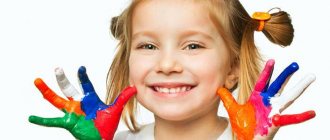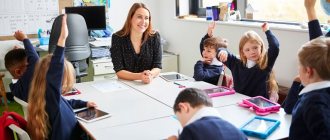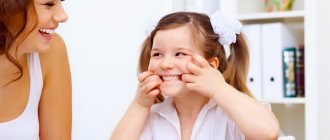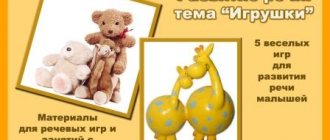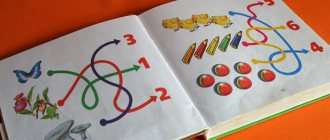Didactic games on valeology
Perhaps, the problem of preserving the health of preschool children is one of the problematic ones if adults do not address it sufficiently. And instilling a caring attitude towards their health in children can be done using a method that children really like - this is a game. So, look at interesting educational games for preschoolers for use both in kindergarten and at home.
Didactic games for preschoolers.
1. Drawing up a model “How to protect yourself from a cold” and “How to behave during an illness”
Goal: To consolidate knowledge about disease prevention
Material: Large cards - 2 pcs. with the image of a sick child; a set of small cards with preventative measures and a set of cards with activities aimed at rapid recovery.
Progress of the game
In front of the child are 2 large cards depicting a sick and healthy child. The child’s task is to create a model of behavior during illness; select the desired set of cards and put them next to the card with the sick child. And also create a model of preventive actions against colds by similarly selecting the necessary ones from the available cards and putting them on a healthy child.
2. Story based on the mnemonic table “If you want to be healthy”
Goal: To consolidate children's knowledge about various factors that contribute to the preservation and strengthening of health.
Material: Mnemonic table “If you want to be healthy”
Progress of the game
On the table there is a mnemonic table “If you want to be healthy.” The teacher asks you to use a mnemonic table to tell you what you need to do to be healthy. The child’s task is to correctly talk about the factors that promote health, using the mnemonic table, without making mistakes.
3. Didactic game “To be healthy, I will...”
Goal: To consolidate children's knowledge about leading a healthy lifestyle.
Material: Subject pictures depicting various positive situations (barefoot walking, sunbathing, sledding, dousing, etc.) and a set of pictures with negative situations.
Progress of the game
The teacher says: “To be healthy, you will...” The child’s task is to complete the first part of the teacher’s sentence and select the appropriate positive story picture.
4. State of the model “Factors that promote health”
Goal: To consolidate children’s knowledge about factors that help improve health
Material: Large sheet with a picture of a person in the center. Colored pencils.
Progress of the game
In front of the child lies a large sheet with a picture of a person in the center. The child’s task is to draw around the person everything that helps improve human health (vitamins, sports, etc.)
5. “Helpful - harmful”
Goal: To consolidate children’s knowledge about the benefits and harms of certain products
Material: Large cards with the image of a cheerful man; a set of cards depicting foods that are healthy and harmful to human health.
Progress of the game
On the table there are 2 large cards with the faces of a cheerful and sad man. The child’s task is to choose cards with products that are good for human health and put them on the card with a cheerful little man, and put cards with products that are harmful to human health on the card with a sad little man.
6. Didactic game on valeology “We are tempering”
Goal: To consolidate knowledge about subjects that help us harden.
Material: Cards depicting items needed for hardening (inventory).
Progress of the game
Children take turns taking a card with a picture of an item needed for hardening. The child’s task is to tell about the purpose of the object and its benefits for hardening the body.
7. “Brew borscht”
Purpose: To give children an idea of how to prepare soup, to consolidate knowledge about vegetables and fruits.
Material: Sets of pictures depicting the products needed for borscht.
Progress of the game
Children take turns choosing appropriate object pictures depicting products for preparing borscht.
8. “A lot is a little”
Goal: To teach children to think about what and in what quantities they can consume without harming their health. To develop the ability to classify foods: sour-sweet, bitter-salty, vegetables-fruits.
Material: Pictures depicting vegetables, fruits; card with questions:
Progress of the game
1.What happens if you eat a lot (picture)?
2.Eating a lot of apples is good...
Eating too many apples is bad...
Task: arrange vegetables and fruits, “tops and roots.”
9. Didactic game on valeology “Vitamin Summer”
Goal: To consolidate knowledge about vitamins and their content in foods.
Material: Large cards (3 pieces) and 32 small cards with images of vegetables and fruits.
Progress of the game
The teacher names vitamins on a large card, and children choose object pictures depicting foods that contain this vitamin and put them next to the corresponding vitamin.
10. Didactic game “Magic Pan”
Goal: Expand the understanding of the variety of dishes.
Material: Image of a pan and cards with images of ready-made dishes and the products from which they were prepared.
Progress of the game
Each child is given a card with a picture of the finished dish. The child’s task is to select an object picture with the necessary products for preparing a given dish. Those who complete the task put their pictures in the magic pan. Everyone checks the correct execution together.
11. Didactic game “Guess the sport”
Goal: To consolidate children's knowledge about different sports.
Material: Cards depicting attributes for each sport.
Progress of the game: The presenter gives the children cards depicting various sports. The child’s task is to select cards with the appropriate attributes for a given sport.
12. Didactic game “Dress the Athlete”
Goal: To teach children the ability to select appropriate equipment and equipment for athletes
Material: Card with images of equipment and equipment of different athletes
Progress of the game
Children are given cards with pictures of athletes from various sports. The child’s task is to select pictures with the appropriate equipment and equipment for a given athlete.
"Me and my health." Valeological games and exercises
According to the World Health Organization, “health is a state of complete physical, mental and social well-being and not merely the absence of disease or injury.”
A number of factors influence a child’s health:
- heredity (share of influence is 20%)
- environmental impact (share of influence - 20%)
- medical care (share of influence - 10%)
- lifestyle (share of influence - 50%).
These data force us to pay the most serious attention to the fourth group of factors. It consists of the child’s attitude to his health, his nutrition, adherence to the daily routine, physical activity, hardening, proper sleep, and mastery of hygiene skills. The games and exercises offered in this section will help children develop the right attitude towards their health.
Who do I look like? Goal: developing the ability to look at oneself from the outside, compare a person with other animal organisms, find similarities and differences, promote the development of imagination.
Material: photographs of parents, other close relatives of children, prizes.
Description: invite children to carefully look at the photographs and find similar features. The one who finds the most signs wins a prize.
Who was born
Goal: to consolidate children’s ideas about how living beings are born.
Equipment: three large pictures depicting an egg, caviar, a bottle of milk and a pacifier; small pictures depicting people, animals, birds, amphibians, insects.
In front of the children are pictures with animals, insects, amphibians, and people turned upside down. Children choose any picture and tell how this creature was born. Then they combine a small picture with a large one - with the image of an egg, an egg, a bottle with a nipple (for mammals).
Gardener
Goal: familiarization with the external structure of the human body, to develop the ability to see the good in other people.
Description: children stand in a circle, the leader is the gardener in the center. He utters the following words: “I was born a gardener, I was seriously angry, I was tired of all the flowers, except for Yulenka! “Then the “gardener” talks about Yulenka’s virtues. Then Yulenka becomes the leading gardener. She chooses one of the guys and tells why he (s) is good, thus explaining her choice.
Name it correctly
Goal: to consolidate knowledge about hygiene products, their purpose and correct use.
Material: subject pictures of various subjects, including images of hygiene products, chips.
Description: children choose from a variety of items those that help them take care of themselves. For example: “I wash my face” (what objects help you with this), “I take a shower,” etc. For the right choice - a trick.
Choose clothes according to the seasons
Goal: developing the ability to distinguish items of clothing depending on the time of year.
Material: items of clothing used in different seasons, 4 dolls.
Description: children are divided into teams, each of which “dresses” its doll for a certain time of year.
Who needs what to live?
Goal: consolidation of knowledge and ideas about the basic needs of living organisms for warmth, air, food, habitat.
Material: cards depicting living beings (human, dog, tree, flower, etc.; cards depicting food, habitat.
Description: invite children to choose a pair for each card, answering the questions - choose what the bird needs to live? What does a dog need so that it can live.
Who am I?
Goal: expanding the child’s knowledge about himself, his name, his surname, age.
Equipment: mirror; subject pictures depicting animals and birds.
Tell us what you know about yourself (name, age, height, hair color and length, eye color, date of birth, girl or boy).
Tell me who you are like: mom or dad.
Do you have signs that are present in any animal or bird?
Health traffic light
Goal: developing ideas about a healthy lifestyle.
Material: circles of red, yellow, green colors, subject pictures.
Description: offer to “light” the health traffic light. The green circle is what helps a person lead a healthy lifestyle; yellow is something that needs to be treated with caution, red circle is something that is harmful to health.
Name the athlete
Goal: to develop a respectful attitude towards athletes, to develop the ability to distinguish and name sports.
Material: pictures of athletes.
Goal: to develop a respectful attitude towards athletes, to develop the ability to distinguish and name sports.
Description: Children play in pairs. One takes a picture of an athlete and shows the given sport with a movement, the other guesses. Then the players change places.
Where are the vitamins hidden?
Goal: to consolidate the understanding of vitamin groups, their importance and health benefits.
Material: baskets with letters indicating groups of vitamins (A, B, C); dummies of fruits and vegetables.
Description: suggest placing the dummies in baskets with the corresponding group of vitamins.
What first - what then (daily routine)
Goal: to reinforce the idea that following a proper daily routine is good for health.
Material: plot pictures depicting actions characteristic of a certain period of the day.
Description: invite players to arrange the pictures in the correct sequence and explain their choice.
Sun, air and water are our faithful friends
Goal: to form an idea about the means and types of hardening (water, air, solar), their importance for health.
Material: story pictures.
Description: children look at the pictures and determine what health benefits the sun, air and water bring. The one who names the most useful properties wins.
Why did the guys get sick?
Goal: to develop the ability to identify cause-and-effect relationships, cultivate a caring attitude towards one’s health, and develop coherent speech.
Material: plot pictures depicting correct and incorrect actions (leading to illness).
Description: children choose pictures depicting incorrect actions and explain their choice.
Name it correctly (medicines)
Goal: familiarize yourself with the names of medications that are used for treatment and which are part of the “home medicine cabinet.”
Material: pictures depicting medications included in the “home first aid kit”, “first aid kit”.
Description: children are invited to assemble a “home first aid kit”, naming medications, and explain their choice.
Choose medicinal plants
Goal: familiarize yourself with the names of medications that are used for treatment and which are part of the “home medicine cabinet.”
Material: subject pictures depicting plants, “Aibolit” doll.
Description: children choose medicinal plants from all the proposed pictures, and “Aibolit” explains what medicinal properties they have.
How should you take care of yourself?
Goal: developing skills to monitor compliance with personal hygiene rules.
Equipment: top, chips, cards with questions.
The presenter spins the top, which determines the card with the question. For the correct answer, the child receives a chip. The one with the most chips wins.
Questions
1. Name the items you need for washing (soap, towel).
2. Name the items you will need to take a shower (shampoo, soap, shower gel).
3. How often should you wash? (Every day).
4. How often should you brush your teeth? (In the morning and in the evening).
5. How often should you cut your nails? (At least once every 10 days).
6. How often should you wash your ears? (Every day).
7. How often should you change your underwear? (Every day).
Show me and I'll guess
Goal: to develop a respectful attitude towards athletes, to develop the ability to distinguish and name sports.
Description: one subgroup of children, using specific movements, shows (makes a guess) what kind of sport they are involved in. Another subgroup guesses who was depicted (skier, swimmer, hockey player, gymnast, etc.).
Good words
Goal: to create a desire to see the good in other people, the development of speech and imagination.
Description: children stand in circles, pass the ball around the circle, name one of the good qualities of their neighbor or call him by an affectionate name.
Making a menu
Goal: developing the idea that health depends on proper nutrition - food should not only be tasty, but also healthy.
Material: play dishes, dummies of fruits, vegetables, food.
Description: The presenter tells the players: “In front of you is a table set for lunch (dinner). Put in the first plate what you want to eat first, then fill the second plate, and the dessert bowl. Mark those players who filled their plates with more than just sweets, and who “created a menu” that is healthy.
To keep your skin healthy
Goal: developing skills to monitor compliance with personal hygiene rules.
Equipment: pictures marked with a red rim with incorrect actions of children.
Children look at the pictures and find what is wrong. For the correct answer, the child receives a chip. The one with the most chips wins.
Images
The child licks abrasions and cuts.
Boy in dirty underwear.
The girl puts on someone else's shoes.
What do we know about things?
Goal: to expand children’s understanding of the rules of safe behavior at home; develop attention and memory; foster a sense of cooperation.
Material: four playing cards depicting a cut, burn, hand bruise and fire; pictures depicting various household items.
Description: 4 children take part in the game, each of them takes a game card with the image of an “injury”. The teacher (child) is the leader. He picks up a picture of an object one by one. Participants must guess what injury could result from improper handling of this item, match it to their card and take the picture. When selecting, the child must explain why this or that object is dangerous and tell the rules for handling it.
Author: Olga Vladimirovna Mozdukova, teacher at MBDOU “Kindergarten No. 3”, Belovo, Kemerovo region, Russia.
The article is published in the author's edition.
Gaming valeological technologies
Today, health improvement is becoming one of the main social problems, so the science of health - valeology - has begun to develop intensively. Many new books, textbooks, and health programs have appeared, the purpose of which is to teach a child to be healthy physically, mentally, and morally.
I, like any teacher, of course, want to see an initiative person in my student. Without personal activity and interest, neither the development of natural (biogenetic) abilities nor knowledge of the surrounding world is possible. The concept of “initiative personality” includes, first of all, such personality qualities as openness (the desire to establish new contacts), mobility (adjust to the situation), and the ability to self-regulate. But didacticism in preschool education is ineffective. The experience of many thousands of generations has shown that the most effective method of education is play. It is impossible to overestimate the role of a child’s play; the game is the child's life itself.
The new (valeological) direction requires new methodological developments: for me, gaming valeological technologies became them. Only by using a leader for a child’s play activity can I give him health, making it interesting, fun, and for life.
The main goal of valeological games is to form ideas about a healthy lifestyle. These games combine educational and recreational goals. Without the closest cooperation between general medicine and general pedagogy, there is no guarantee not only of lasting vital results, but also of the formation and consolidation of biological and social stability and high mobility of the child’s body.
Based on the basic principles of valeological education, three areas of valeological games can be distinguished.
Matrix games.
These are integrated games that combine the capabilities to solve a large number of educational and recreational tasks, united by a common block theme. The choice of a specific topic will vary depending on the tasks that I set for myself based on my program. Mental, emotional state of children and other factors.
The matrix is the basic model. It can be presented in the form of a residential building, or a castle with rooms, halls, playgrounds, with corresponding characters, attributes, and game tasks. This structure of the basic model provides wide creative opportunities for my work both in studying topics (hygiene rules, nutritional culture, etc.) and in generalizing knowledge on block topics (daily routine, sports, etc.) .
Matrix games are designed for use in various age groups. First, children are given primary knowledge about individual concepts, and then, thanks to the mobility of the basic model, this knowledge is expanded and consolidated.
An example is the valeological matrix game “House of the Dwarves”, which is designed in the form of a house of six rooms (entrance hall, living room, bathroom, bedroom, playroom, kitchen).
For example, if I take the main topic “Daily Routine”, then topics such as “Nutrition”, “Clothing”, “Cultural hygiene skills”, etc. are considered separately. At the first stage, an acquaintance takes place with the “owners” of the house, the gnomes and Snow White. Then, based on the set goal, we get acquainted with how the day goes in the house (consolidating and forming knowledge about the need to adhere to the daily routine), or we stop in one of the rooms to play “inside” it. (“Help Snow White set the table”, “Gather the gnomes for a walk”, etc.).
Travel games
When introducing children to the internal structure of the human body, I often had difficulties. It was not always interesting and even unpleasant for children to examine the anatomical structure of the internal organs and systems of the body. When I started using an anatomical atlas for preschoolers, where the main systems and internal organs of a person are presented in the form of colorful
. fairytale maps, activities turned into a game with travel around the map. The inhabitants of the magic map talk about themselves in a funny and accessible way. About what they love and what harms them.
In this way, children not only absorb the scientific knowledge available to them. But they develop a desire to help their body be healthy.
First, I invite children to get acquainted with the structure and functions of individual organs, and then take them on a journey through one of the systems, consolidating knowledge about its components and its work.
The science-fiction plot of the journey leads children to the idea that every organ of the human body is important and necessary, that all organs are interconnected and act together.
I conduct travel games in the preparatory group on the topics: “The Journey of the Pie” (introduction to the digestive system), “The Journey of Prince Oxygen” (introduction to the respiratory system), “We are captains” (introduction to the circulatory system).
Valeological tales
New knowledge about the structure of a person, the functions and work of internal organs should be of practical importance for the child. The main idea of valeological fairy tales comes down to the main task - to teach a child to be healthy. Fairy tales model situations related to the causes of illnesses, injuries, and practical lessons on how to avoid these troubles and what to do if trouble does occur.
I don’t just read fairy tales to children, but always act them out (finger theater, flannelgraph). The brightness of the images helps to enliven the plot and make it more visual. It is easier for children to “enter a fairy tale and complete it”, figuring out how to help the main character. In this way, a model of correct behavior is formed in children.
In the future, when faced with a similar situation, they will be ready for it, they will know what to do and how to behave.
Psychologists have long been using the fairy tale therapy method in their work and have proven its effectiveness, especially in cases where it is necessary to help a child overcome internal fears about visiting a doctor, injections, etc.

